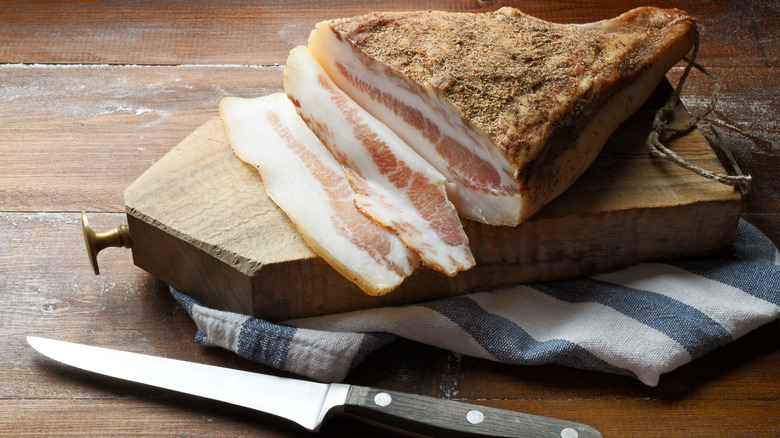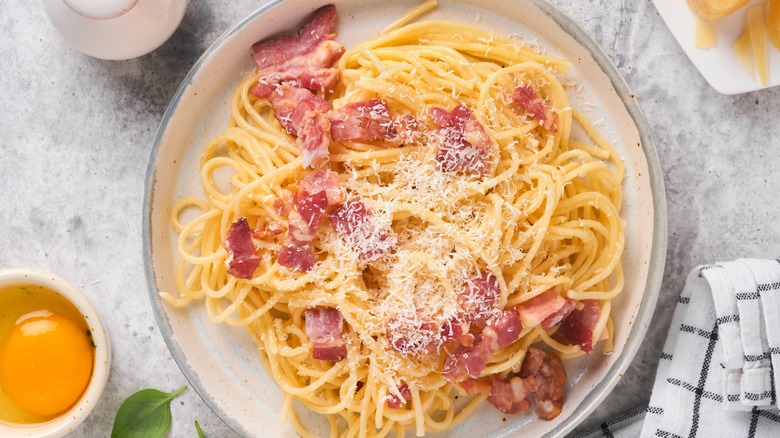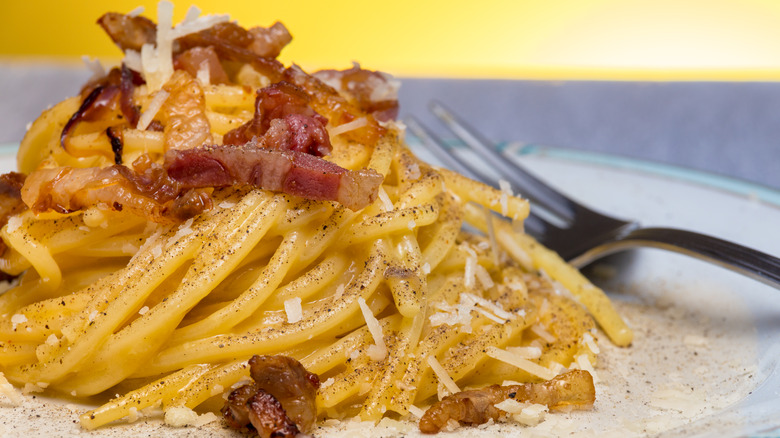What Makes Guanciale Different From Pancetta
Italy is serious about its cuisine, and perhaps no food group better exemplifies the country's culinary commitment than cured meats. Look beyond — even within — Italy's dazzling pasta and pizza dishes to what comes before. The antipasto, or first course, is the sneaky star of the dinner show.
Italian chef Mario Batali outlines just a few of the meats that frequent Italian starter platters. Per Food52, Italian meats encompass everything from spicy salami to pistachio-studded mortadella to thin, beefy bresaola. And, of course, who can forget about prosciutto, Italy's hallmark ham?
Yet two of the most popular Italian meats aren't frequent fliers on antipasto boards. Though Batali references pancetta as a go-to cured meat, even he acknowledges that it's more commonly used in pasta dishes. Both pancetta and guanciale are iterations of cured, spiced, and dried pork. They're commonly incorporated into cooking, sprucing up any and all pastas (via Food Network).
Yet while the meats seem and even look relatively similar, they aren't actually interchangeable. The signature difference between pancetta and guanciale comes down to their respective origins; one is pork jowl, and the other is pork belly. This seemingly subtle difference results in varied fat ratios and ultimately lends itself to individual flavors — not to mention varied uses in the kitchen.
Pancetta is cured pork that mixes the lean with the fat
Often compared to bacon, pancetta is a cured derivative of pork belly. It is somewhat similar to bacon in flavor and texture but is typically not smoked. According to La Cucina Italiana, pancetta maintains a ratio of both lean meat and fat. It often comes rolled and is later diced and cooked for flavor. It requires roughly three weeks to cure before hitting shelves. Sometimes the process takes longer.
When buying pancetta, ask for your block whole. Celebrity chef Ina Garten recommends slicing and dicing pancetta from home to ensure your desired thickness. If you're using it for an antipasto board, stick with thin slices. As Battali mentioned, pancetta deserves a place amongst the best cured meats and can be enjoyed as a cold cut with vinegar and oil (per La Cucina Italiana).
However, pancetta is also used as a cooking ingredient, capable of getting sliced, diced, and minced for any and all purposes. It is this function that most closely compares with that of guanciale.
Guanciale comes from pork jowl and retains a higher quantity of fat
Guanciale is all in the jowl, says La Cucina Italiana, already distinguishing guanciale's start from pancetta's stomach origins. Like pancetta, guanciale is seasoned but is subsequently aged for about three months rather than mere weeks. According to Masterclass, guanciale's seasonings are also more intensive; the meat receives a combination of salt, pepper, sage, garlic, and rosemary. This mixture, not to mention the minimum three-month curing period, results in a distinct and complex meat. For comparison, pancetta calls entirely for salt during the rapid curing stage, which ultimately yields less complexity.
Yet while thoroughly cured, guanciale is less commonly known in America and often takes a back seat to other meats — and for no good reason, laments Due Cucina. The Pacific Northwest-based Italian eatery defines guanciale as a culinary staple in central Italy. Due Cucina features guanciale throughout its own dishes.
The reason for guanciale's starring role comes down to its taste — a byproduct of its fat content. Guanciale, per Masterclass, is less lean than pancetta. When incorporated into pasta sauces, the fat of guanciale melts into the dish, adding depth and flavor that exceeds the meat itself (via Due Cucina). It is this distinction that makes guanciale the ideal option for pasta dishes.
Different recipes call for different meats
The strength of guanciale's smell, taste, and fat content makes it a go-to ingredient throughout Italian cooking. It commonly appears in Roman pasta dishes like spaghetti alla gricia, amatriciana, and carbonara (via La Cucina Italiana). Masterclass recommends using guanciale in these meals for a burst of rich, fatty flavor. While pancetta works just fine in these foods, it's not quite as savory as guanciale. Rather, pancetta has its own purposes: gather thin slices for your next food board, or go ahead and throw some into your favorite salad, pizza, or pasta.
While guanciale seems to be your best bet in rich dishes, you ultimately can't go wrong with pancetta — nor can you truly fail with the addition of bacon or even zucchini. The Roman restaurant Nonna Betta makes Kosher-friendly pasta dishes, so swapping guanciale in and out of your favorite foods doesn't have to contradict Italian tradition. You can easily do as the Romans do, whether you're cooking with guanciale, pancetta, vegetables, or yet another cured meat. Each is guaranteed to add a burst of flavor to any Italian dish.



